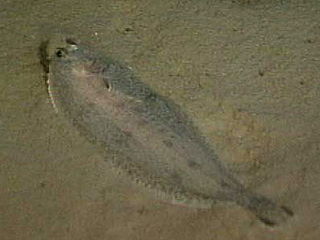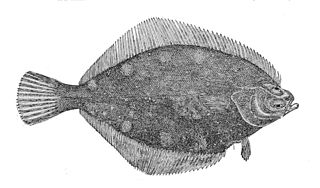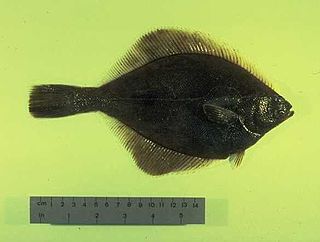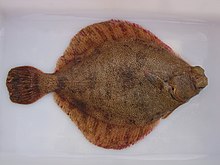
A flatfish is a member of the ray-finned demersal fish order Pleuronectiformes, also called the Heterosomata, sometimes classified as a suborder of Perciformes. In many species, both eyes lie on one side of the head, one or the other migrating through or around the head during development. Some species face their left sides upward, some face their right sides upward, and others face either side upward.

The European plaice, commonly referred to as simply plaice, is a species of marine flatfish in the genus Pleuronectes of the family Pleuronectidae.

The starry flounder, also known as the grindstone, emery wheel and long-nosed flounder, is a common flatfish found around the margins of the North Pacific.

The megrim, megrim sole, whiff, or Cornish sole is a species of left-eyed flatfish in the family Scophthalmidae. It is found in the northeast Atlantic and Mediterranean Sea between 100 and 700 m below sea level. It is caught commercially by some countries.

The witch, known in English by a variety of other common names including the witch flounder, pole flounder, craig fluke, Torbay sole, and grey sole, is a species of flatfish from the family Pleuronectidae. It occurs on both sides of the North Atlantic Ocean on muddy sea beds in quite deep water. In northern Europe it has some importance in fisheries as a food fish.

The European flounder is a flatfish of European coastal waters from the White Sea in the north to the Mediterranean and the Black Sea in the south. It has been introduced into the United States and Canada accidentally through transport in ballast water. It is caught and used for human consumption.

Samaridae is a family of crested flounders, small flatfishes native to the Indo-Pacific. The family contains four genera with a total of 29 species.

The solenette or yellow sole, Buglossidium luteum, is a species of flatfish in the family Soleidae, and the only member of its genus. It is characterized by its small size, low-slung semi-circular mouth, and regularly placed dark fin rays. A common and widespread species, it is native to sandy bottoms in the northeastern Atlantic Ocean and the Mediterranean Sea. It is of little commercial value.

Symphurus thermophilus is a species of tonguefish notable for being the only flatfish known to be an obligate inhabitant of hydrothermal vents. It is known to inhabit several widely dispersed locations in the western Pacific Ocean and occurs in great numbers. These flatfish are distinguished by the prominent dark crossbands on their brown eyed side, black abdominal cavity membrane lining known as the peritoneum, and white blind side. They are tolerant of harsh conditions and are often found in close association with elemental sulfur, including molten sulfur pools that exceed 180 °C in temperature. As they are not significantly different in appearance and feeding habits from other tonguefishes, they are thought to be relatively recent colonizers of vent ecosystems.

Pleuronichthys is a genus of fish in the family Pleuronectidae found in the Pacific Ocean.

The butter sole is an edible flatfish of the family Pleuronectidae. It is a demersal fish that lives on soft, silty bottoms in temperate waters at depths between 20 and 425 m. Its native habitat is the northeastern Pacific, from the Bering Sea and the Aleutian Islands, along the coasts of Alaska, Canada, and the USA as far south as Ventura, California. It grows up to 55 cm (22 in) in length, and can live for up to 11 years.

The rex sole is a flatfish of the family Pleuronectidae. Locally, it may also be known as a witch or threadfin sole. It is a demersal fish that lives in temperate waters on sand or mud bottoms at depths of up to 900 metres (3,000 ft), though it is most commonly found between 61 and 500 metres. Its native habitat is the northern Pacific, from Baja California in Mexico up the coasts of the United States, British Columbia and Alaska, across the Bering Sea to the coast of Russia and the Sea of Japan. It is slow-growing, reaching up to 60 centimetres (24 in) in length, and it can weigh up to 2.0 kilograms (4.4 lb). Maximum reported lifespan is 24 years.

The rock sole, also known as the Pacific rock sole or Southern rock sole is a flatfish of the family Pleuronectidae. It is a demersal fish that lives on sand and gravel bottoms at depths of up to 575 metres (1,886 ft), though it is most commonly found between 0 and 183 metres. Its native habitat is the temperate waters of the northern Pacific, from Baja California to Alaska, the Aleutian Islands and southeastern parts of the Bering Sea. It grows up to 60 centimetres (24 in) in length and can weigh up to 1.8 kilograms (4.0 lb), and has a maximum recorded lifespan of 22 years.

The C-O sole is a species of flatfish in the family Pleuronectidae. It is a demersal fish that lives on flat bottoms and rocky areas at depths of between 18 and 350 metres. Its native habitat is the temperate waters of the eastern Pacific, ranging from Sitka, Alaska in the north to San Quintín, Baja California in the south. It can grow up to 36 centimetres (14 in) in length.

The yellowfin sole is a flatfish of the family Pleuronectidae. It is a demersal fish that lives on soft, sandy bottoms at depths of up to 700 metres (2,300 ft), though it is most commonly found at depths of around 91 metres (299 ft). Its native habitat is the temperate waters of the northern Pacific, from Korea and the Sea of Japan to the Sea of Okhotsk, the Bering Sea and Barkley Sound on the west coast of Canada. Males grow up to 49 cm (19 in) in length, though the common length is around 33.5 cm (13.2 in). The maximum recorded weight is 1.7 kg (3.7 lb), and the maximum recorded lifespan is 26 years.

The Sakhalin sole is a flatfish of the family Pleuronectidae. It is a demersal fish that lives on bottoms at depths of between 10 and 360 metres, though it is most commonly found between around 50 and 100 metres. Its native habitat is the polar waters of the northwestern Pacific, from the Sea of Okhotsk to the west and central Bering Sea, as far as the Pribilof Islands. It can reach up to 36 centimetres (14 in) in length, though the common length is around 21.5 centimetres (8.5 in). The maximum recorded weight is 500 grams (18 oz), and the maximum recorded lifespan is 8 years.
The narrow-body righteye flounder is a flatfish of the family Pleuronectidae. It is a demersal fish that lives on saltwater bottoms at depths of between 218 and 438 metres. Its natural habitat is the waters of the Indo-West Pacific, from the Bali Strait to Northern Territory, Queensland and New South Wales in Australia. It can grow up to 15 centimetres (5.9 in) in length.

Zebrias is a genus of ray-finned fish in the family Soleidae.

Zeugopterus punctatus, the common topknot, is a species of left eyed flatfish in the family Scophthalmidae, from the eastern Atlantic Ocean.

The Egyptian sole is a species of flatfish in the true sole family, Soleidae. It lives on the sandy or muddy seabed of the Mediterranean Sea, and is now colonising the Red Sea. It often semi-immerses itself in the substrate. The upper side is greyish-brown while the underside is white. It grows to a maximum length of about 70 cm (28 in). This fish is used for human consumption and is prized as a food fish. It is caught mostly by trawling on the seabed.























